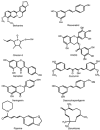Cancer prevention and therapy through the modulation of the tumor microenvironment
- PMID: 25865775
- PMCID: PMC4930000
- DOI: 10.1016/j.semcancer.2015.02.007
Cancer prevention and therapy through the modulation of the tumor microenvironment
Abstract
Cancer arises in the context of an in vivo tumor microenvironment. This microenvironment is both a cause and consequence of tumorigenesis. Tumor and host cells co-evolve dynamically through indirect and direct cellular interactions, eliciting multiscale effects on many biological programs, including cellular proliferation, growth, and metabolism, as well as angiogenesis and hypoxia and innate and adaptive immunity. Here we highlight specific biological processes that could be exploited as targets for the prevention and therapy of cancer. Specifically, we describe how inhibition of targets such as cholesterol synthesis and metabolites, reactive oxygen species and hypoxia, macrophage activation and conversion, indoleamine 2,3-dioxygenase regulation of dendritic cells, vascular endothelial growth factor regulation of angiogenesis, fibrosis inhibition, endoglin, and Janus kinase signaling emerge as examples of important potential nexuses in the regulation of tumorigenesis and the tumor microenvironment that can be targeted. We have also identified therapeutic agents as approaches, in particular natural products such as berberine, resveratrol, onionin A, epigallocatechin gallate, genistein, curcumin, naringenin, desoxyrhapontigenin, piperine, and zerumbone, that may warrant further investigation to target the tumor microenvironment for the treatment and/or prevention of cancer.
Keywords: Cancer biology; Cancer prevention; Cancer therapy; Tumor microenvironment.
Copyright © 2015 Elsevier Ltd. All rights reserved.
Conflict of interest statement
All authors disclose no financial conflicts of interest.
Figures


References
-
- Hanahan D, Weinberg RA. Hallmarks of cancer: the next generation. Cell. 2011;144:646–74. - PubMed
Publication types
MeSH terms
Substances
Grants and funding
- R21CA169964/CA/NCI NIH HHS/United States
- R21 CA169964/CA/NCI NIH HHS/United States
- R01 CA170378/CA/NCI NIH HHS/United States
- P01 CA034233/CA/NCI NIH HHS/United States
- R01 CA089305/CA/NCI NIH HHS/United States
- U54CA149145/CA/NCI NIH HHS/United States
- F32 CA177139/CA/NCI NIH HHS/United States
- F32CA177139/CA/NCI NIH HHS/United States
- U54 CA149145/CA/NCI NIH HHS/United States
- R01CA184384/CA/NCI NIH HHS/United States
- R01CA128704/CA/NCI NIH HHS/United States
- P50CA114747/CA/NCI NIH HHS/United States
- R15 CA137499/CA/NCI NIH HHS/United States
- C301/A14762/CRUK_/Cancer Research UK/United Kingdom
- R01CA170378/CA/NCI NIH HHS/United States
- U01 CA188383/CA/NCI NIH HHS/United States
- R01 CA105102/CA/NCI NIH HHS/United States
- ImNIH/Intramural NIH HHS/United States
- R15 CA137499-01/CA/NCI NIH HHS/United States
- R01 CA184384/CA/NCI NIH HHS/United States
- P50 CA114747/CA/NCI NIH HHS/United States
LinkOut - more resources
Full Text Sources
Other Literature Sources

